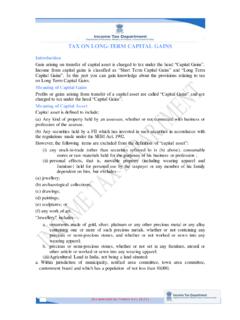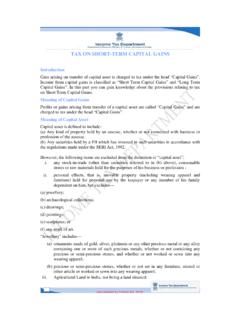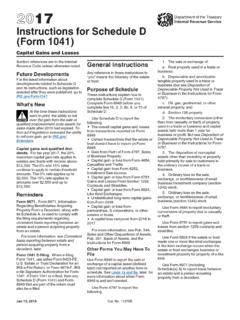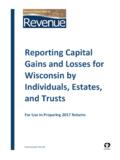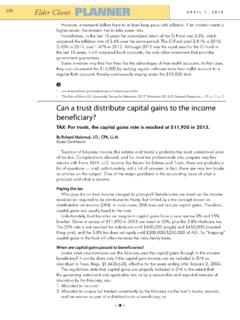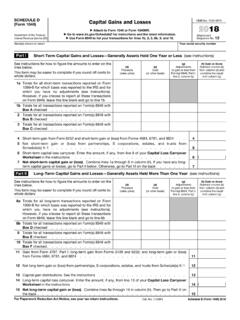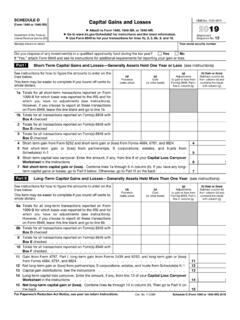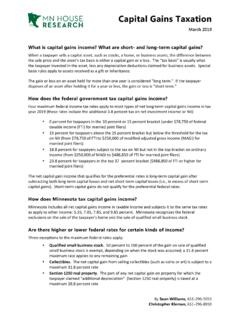Transcription of Income Tax Reporting of Livestock Sales - SE Cattle Advisor
1 1 AGECON-11-002 Income Tax Reporting of Livestock Sales Keith D. Kightlinger, Extension Economist Cooperative Extension, The University of Georgia Department of Agricultural and Applied Economics College of Agricultural and Environmental Sciences Livestock producers need to be familiar with the rules for Reporting Livestock Sales on their Income tax returns. Posting Sales in their farm business records by how the sale will be reported on the Income tax return provides the producer and his or her tax preparer with information for accurate Income tax planning as well as for accurate tax return preparation. This article deals with Sales by cash basis taxpayers. The producer also benefits from posting Livestock Sales by the type of Livestock also assists the producer in making herd management decisions throughout the Livestock production cycle.
2 Market Livestock Market Livestock are animals held for sale in the ordinary course of the taxpayer s business. All animals held by a Livestock producer, whether raised or purchased, are considered to be held for sale (or resale, for purchased animals) until they are selected to be held for breeding, dairy or draft purposes. The act of selecting to hold an animal for breeding, dairy or draft purposes will be discussed in the Breeding Stock section of this article. If an animal is held for sale in the ordinary course of the taxpayer s business, the Income from the sale will be ordinary Income , taxed at the taxpayer s marginal ordinary Income tax rate. Livestock purchased for the purpose of feeding and re-selling at a higher weight are considered to be market Livestock , along with raised Livestock not selected for breeding by the producer, and poultry.
3 Reporting Sales Sales of market Livestock are reported on the Livestock producer s business Income tax return, which will be Schedule F, Form 1040 for sole proprietors and partnerships. Schedule F, Form 1040 may also be used as an attachment to the tax return for Reporting farm incomes and expenses of corporations filing Form 1120 or 1120-S. Landlords who do not materially participate in the activities of a Livestock share lease report market Livestock Sales on Form 4835. Sales of raised market Livestock are reported on line 4 of Schedule F ( Sales of Livestock , produce, grains, and other products you raised). Form 4835 filers report raised market Livestock Sales on line 1 ( Income from production of Livestock , produce, grains, and other crops) of that Form. Sales of purchased market Livestock (feeder animals) is reported on line 1 of Schedule F, Form 1040 by materially participating taxpayers, and on line 1 of Form 4835 by Livestock share lease landlords.
4 The purchase cost of the animals sold is reported on line 2 if Schedule F, Form 1040 is being filed, or on line 30 (with description) if Form 4835 is being filed. The purchase cost of market Livestock sold is claimed as a deduction in the year the animals are sold, not in the year they are purchased. 2 Breeding Livestock The term breeding Livestock will be used to describe all Livestock held for breeding, dairy or draft purposes. The Reporting of the sale or other disposition of a breeding animal and taxation of the gain (or loss) resulting from the disposition is determined by: Whether the animal was raised or purchased How long the animal has been held for breeding by the taxpayer, and Whether the disposition resulted in a gain or a loss Raised Breeding Stock The sale of raised a breeding animal results in a taxable gain , since the producer has deducted the cost of raising the animal to the age when it was selected for breeding as ordinary business expenses in the year(s) the expenses were paid, leaving the animal with a zero ($ ) cost basis for Income tax purposes.
5 The sale will be reported on Form 4797 ( Sales of Business Property) for all taxpayers. Purchased Breeding Stock The sale of purchased breeding stock may result in either a taxable gain or loss, depending on whether the amount received for the sale or other disposition is greater or lesser than the adjusted basis of the animal. Purchased breeding animals are depreciable assets used in a trade or business. The table below shows the General Depreciation System (GDS) and Alternate Depreciation (ADS) recovery period in years for the different types of Livestock . Type of Livestock GDS Years ADS Years Hogs 3 3 Goats and Sheep 5 5 Cattle (dairy or breeding) 5 7 Horses (age when placed in service) Breeding or Working, age 12 or less 7 10 Breeding or Working, past age 12 3 10 Racing Horses 3 12 Holding Period The period of time that a breeding animal is held by the taxpayer determines whether a gain in excess of recapture of depreciation ( capital gain ) on the sale or other disposition will be treated as a short-term gain or a long -term gain .
6 The holding period which must be exceeded for a gain to be considered a long -term gain is 12 months for hogs, and 24 months for all other Livestock . Sec. 1231 Internal Revenue Code Section 1231 ( 1231) gives special tax treatment to gains and losses realized on capital assets used in a trade or business, when the holding period for the asset is met. Generally, both gains and losses resulting from Sales of capital assets for which the holding period has been met are treated as capital gains and losses. capital losses generated in a given tax year can be used by a taxpayer to offset current and prior years capital gains, plus up to $3,000 of ordinary Income . capital losses exceeding these limits cannot be currently used, but can be carried forward indefinitely. In the case of 1231 assets, losses are treated as ordinary losses, and can offset any Income on the current year tax return, while gains are treated as capital gains taxed under the special capital gains tax rules.
7 The taxation of 1231 gains as long -term capital gains comes with a caveat, however. The long -term capital gain treatment for net 1231 gains applies only to the extent that the gains exceed 1231 losses incurred in the past five tax years. If the taxpayer has an 1231 loss in the five previous tax years which has not been recaptured by having an 1231 gain reported as an ordinary 3 gain rather than a long -term capital gain , then current year 1231 gains must be reported as ordinary gains to the extent that any unrecaptured 1231 losses exist in the five previous tax years. If there are no unrecaptured 1231 losses, the gains are recognized as long -term capital gains. Any future 1231 losses will not affect this characterization. This rule applies to all 1231 assets (assets used in a trade or business). Example: Brian Angus had no unrecaptured 1231 losses at the end of the 2004 tax year.
8 In 2005 he had a $50,000 1231 gain from the sale of farm land. Since there are no unrecaptured losses in the past five years, the entire gain is treated as a long -term capital gain . In 2006, Brian incurred a $12,000 1231 loss resulting from the Sales of purchased breeding Livestock . In 2007, 2008, 2009 and 2010, Brian realized 1231 gains of $5,000, $3,000, $3,000 and $6,000, respectively. All of the gains realized in 2007, 2008 and 2009 are treated as ordinary gains, since they collectively are less than the 1231 loss from 2006. The $6,000 gain realized in 2010 is allocated as follows: $1,000 is an ordinary gain , completing the recapture of the 2006 1231 loss, and $5,000 is a long -term capital gain . If Brian has a net gain on 1231 dispositions in 2011, the gain will all be a long -term capital gain , since there are no longer any unrecaptured 1231 losses in the five prior tax years.
9 Quick Reference for Livestock Sales Reporting Category Rules Where Reported Livestock held in the ordinary course of business (Market Livestock ) Not 1231 property, subject to S/E tax Schedule F (Form 1040) Livestock held for breeding, but holding period not met Not 1231 property, not subject to S/E tax Form 4797 Part II Livestock held for breeding, holding period is met 1231 property, not subject to S/E tax a. Raised animals and purchased animals sold at a loss No depreciation recapture Form 4797 Part I b. Purchased animals sold at a gain Subject to depreciation recapture and unrecaptured 1231 loss rules Form 4797 Part III The University of Georgia College of Agricultural and Environmental Sciences, Fort Valley State University, US Department of Agriculture, and counties of the state cooperating. The University of Georgia College of Agricultural and Environmental Sciences Cooperative Extension Service offers educational programs, assistance and materials to all people without regard to race, color, national origin, age, gender, or disability.
10 An equal opportunity / affirmative action organization committed to a diverse work force Issued in furtherance of Cooperative Extension Acts of May 8 and June 30, 1914, the University of Georgia College of Agricultural and Environmental Sciences and US Department of Agriculture cooperating J. Scott Angle, Dean and Director Beverly Sparks, Associate Dean for Extension AGECON-11-002 Department of Agricultural and Applied Economics January 2011
